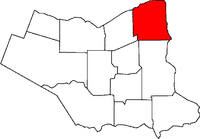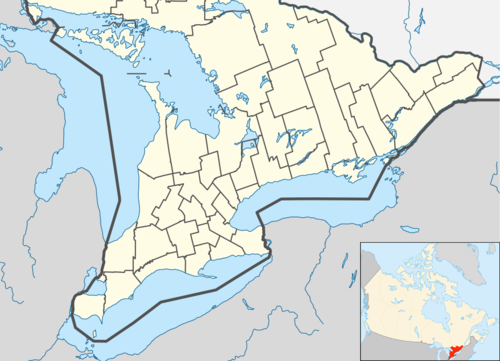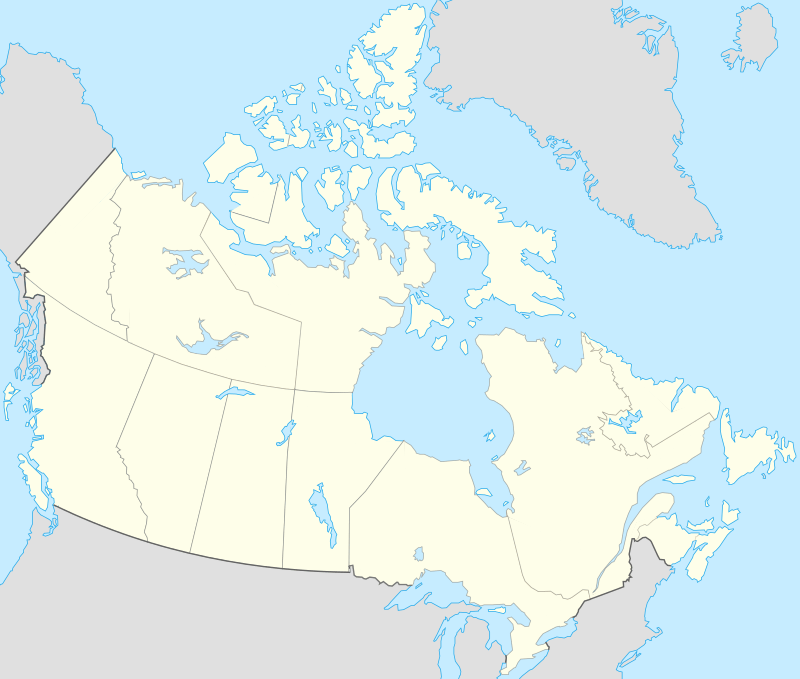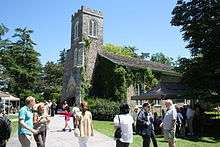Niagara-on-the-Lake
Niagara-on-the-Lake is a town in Ontario, Canada. It is located on the Niagara Peninsula at the point where the Niagara River meets Lake Ontario, across the river from New York, United States. Niagara-on-the-Lake is in the Niagara Region of Ontario, and is the only town in Canada that has a Lord Mayor.[3] It has a population of 17,511 (2016).
Niagara-on-the-Lake, Ontario | |
|---|---|
Town (lower-tier) | |
| Town of Niagara-on-the-Lake | |
 | |
| Nickname(s): The Loveliest Town in Canada | |
 Location of Niagara-on-the-Lake in the Niagara Region | |
 Niagara-on-the-Lake Location in southern Ontario  Niagara-on-the-Lake Niagara-on-the-Lake (Ontario)  Niagara-on-the-Lake Niagara-on-the-Lake (Canada) | |
| Coordinates: 43°15′19″N 79°4′18″W | |
| Country | |
| Province | |
| Region | Niagara |
| Settled | 1781 |
| Incorporated | 1792 |
| Government | |
| • Lord Mayor | Betty Disero |
| • Governing body[1] | Town Council |
| • MP | Tony Baldinelli |
| • MPP | Wayne Gates |
| Area | |
| • Land | 132.81 km2 (51.28 sq mi) |
| Elevation | 82.3 m (270.0 ft) |
| Population (2016) | |
| • Total | 17,511 |
| • Density | 131.8/km2 (341/sq mi) |
| [2] | |
| Demonym(s) | NOTLer |
| Time zone | UTC-5 (Eastern (EST)) |
| • Summer (DST) | UTC-4 (Eastern Daylight (EDT)) |
| Postal code | L0S 1J0 |
| Area code(s) | 905/289 |
| Website | www.notl.org |


Niagara-on-the-Lake is important in the history of Canada: it served as the first capital of the Province of Upper Canada, the predecessor of Ontario, called Newark from 1792 to 1797. During the War of 1812, the town, the two former villages of St. David's and Queenston, and Fort George were the site of numerous battles following the American invasion of Upper Canada, and the town was razed. Niagara-on-the-Lake is home to the oldest Anglican and Catholic churches in Ontario, and the oldest surviving golf course in North America.
Today, Niagara-on-the-Lake draws tourists with its quaint colonial-style buildings, the Shaw Festival, Fort George, wineries, an outlet mall on the highway, and its proximity to Niagara Falls.[4] The Niagara Region has the second-highest percentage of seniors in Ontario. Niagara-on-the-Lake has been rated among the best places to retire in Ontario according to Comfort Life, a publication for seniors.[5]
History
Before the British settlers came, the point where Fort Mississauga is situated was used by at least three Native American tribes: the Neutral (15th century); Seneca (late 17th century); and Mississauga (18th century).
The settlement was founded in 1781 as Butlersburg, in honour of Colonel John Butler, the commander of Butler's Rangers. It was later renamed West Niagara to distinguish it from Fort Niagara.[6] It was a British military base and haven for pro-British loyalists fleeing the United States during the volatile aftermath of the American Revolution.[7]
Renamed Newark by Lieutenant-Governor John Graves Simcoe in 1792, it was the first capital of Upper Canada (now the province of Ontario). The Upper Canada legislature first met at Navy Hall on September 17, 1792 and met here another four times until June 1796.[7][8] In 1797, Simcoe moved the capital to York because Newark was very close to the border with the U.S. Newark was renamed Niagara in 1798.[6]
Fort George, just south of the settlement, was built in 1796-1799. During the War of 1812, Niagara was taken in the Battle of Fort George by American forces in May 1813 after a two-day bombardment by cannon from Fort Niagara and the American fleet, followed by a fierce battle. After capturing Fort George, the Americans built their own fortifications here. The fort was retaken by the British in December 1813 but left to fall into ruins and abandoned in 1815. Only a small portion of the fort remains; it has been fully restored.[9] Fort Mississauga was built, starting in 1813, but was not completed until after the war in 1816.
During the war, the settlement of Niagara was razed and burnt to the ground by American soldiers as they withdrew to Fort Niagara. (Afterwards, on December 19, 1813, the British captured Fort Niagara.)[10] The citizens rebuilt Niagara after the war, with the residential quarter around Queen Street and toward King Street, where the new Court House was rebuilt out of range of Fort Niagara's cannons.[7]
The Smith's Canadian Gazetteer of 1846 describes "Niagara (formerly called Newark)" as follows:
"It has been a place of considerable trade. On the east side of the town is a large military reserve. About half a mile up the river are the ruins of Fort George, where the remains of General Brock were originally interred; they were removed. A new town-hall and court-house are intended to be erected by the town. There is a fire brigade with two engines and a hook and ladder company. Churches and chapels total five. Two newspapers are published weekly .... Steamboats run daily, as long as the weather will allow of it, from Toronto .... The Niagara Harbour and Dock Company were incorporated in the year 1830 .... the vessels turned out by the Company [include] the steamboat "London," which commenced running in the spring of 1845, the fastest boat on the upper lakes... The Company usually employ about 150 hands; and, when particularly busy, have employed as many as 350. There is also on the premises a marine railway, large enough for hauling up vessels of the first class. Post Office, post every day. Professions and Trades.—Three physicians and surgeons, nine lawyers, twelve stores, taverns, two chemists and druggists, three booksellers and stationers, two saddlers, four wagon makers, two watchmakers, two tallow-chandlers, marble works, two printers, two cabinet makers, one hatter, four bakers, two livery stables, two tinsmiths, three blacksmiths, six tailors, seven shoemakers, one tobacconist, one bank agency, .... large quantities of apples, peaches, and cider are shipped annually."[11]
In 1859 the town built its first public school, Niagara Public School.[12]
The town's present name of Niagara-on-the-Lake was adopted around 1880 as a Postal Address to distinguish the town from Niagara Falls. The name was not officially adopted until 1970, when the Town of Niagara and the Township of Niagara merged.[7]
Historic sites
Most of the former military sites, such as Fort George, Navy Hall, and Butler's Barracks, have been restored. Fort George's restoration was done as a "Make Work Project," guided by plans from the Royal Engineers during the Great Depression of the 1930s, an early example of historic preservation. Fort George National Historic Site is a focal point in a collection of War of 1812 sites which, collectively, are managed by Parks Canada under the name Niagara National Historic Sites. That administrative name includes several national historic sites: Fort Mississauga, Mississauga Point Lighthouse (1804, the first on the Great Lakes), Navy Hall, Butler's Barracks, and Queenston Heights.


Niagara-on-the-Lake features historical plaques.[13] Critical battles in the defence of Upper Canada took place here, and at nearby at Queenston and St. David's, both now part of Niagara-on-the-Lake. In one of these, Laura Secord gained her fame.
The town gave many African-Americans their first taste of freedom, both as a stop on the Underground Railroad for those travelling further into Upper Canada, and as a refuge in its own right. Its stock of Regency and Classical Revival buildings, considered the best in the country from the post-War of 1812 period, led the Historic Sites and Monuments Board of Canada to recommend the town's historic district be designated a National Historic Site of Canada, a designation which was approved in 2003.[14][15] The historic centre had been designated as a provincial Heritage Conservation District under the Ontario Heritage Act in 1986. Although it did not make the final list, the Historic District was considered for nomination as a World Heritage Site.[16]
Other significant sites in Niagara-on-the-Lake:
- The town has other National Historic Sites of Canada within its boundaries: the Battlefield of Fort George[17] and nearby Fort George,[18] Butler's Barracks,[19] Fort Drummond,[20] Fort Mississauga,[21] the site of the Mississauga Point Lighthouse,[22] the Niagara Apothecary (the oldest apothecary in Canada),[23] the Niagara District Court House,[24] Queenston Heights,[25][26] Queenston-Chippawa Hydro-electric Plant,[27][28] Willowbank[29][30] and Vrooman's Battery.[31]
- Old Court House Theatre 1847
- Queen's Royal Park - site former Queen's Royal Hotel c. 1860s and demolished 1930.[32]
- St. Mark's Church 1791 - oldest Anglican Church in Ontario
- St. Vincent de Paul 1826 - oldest Catholic Church in Ontario
- McFarland House, built ca. 1800, is Niagara-on-the-Lake's oldest building. During the War of 1812, the house was used as a hospital and officers' quarters, therefore it survived the Burning on Newark in December 1813. It is open to the public for guided tours, as well as a tea patio and mini cafe.
- Niagara Public School, built in 1859.
- Niagara Golf Club 1875 - oldest golf course in North America still in use.
Government
Niagara-on-the-Lake is within the federal electoral district of Niagara Falls, currently represented in the House of Commons of Canada by Tony Baldinelli, and the provincial electoral district of Niagara Falls, represented in the Legislative Assembly of Ontario by Wayne Gates.
It is the only municipality in Canada whose elected leader is designated as Lord Mayor, a title most common in the United Kingdom.[3] Popular legend suggests Prince Edward, Duke of Kent and Strathearn bestowed the title on the mayor of Niagara during a visit to the town in the early 1800s, in recognition of the town's history as the first capital of Upper Canada;[3] however, there is no record of a mayor using it until Jerry Mussen in the early 1920s, and even afterward the title was used only irregularly until the Regional Municipality of Niagara Act of 1969 legislated that "The mayor of the Town of Niagara-on-the-Lake shall be known as the Lord Mayor."[3] The town's current Lord Mayor is Betty Disero, a former Toronto city councillor, as of the 2018 municipal election.[33] Previous Lord Mayors have included Patrick Darte, Dave Eke, Gary Burroughs, Art Viola, Mike Dietsch, Stan Ignatczyk, Jim Marino, Wilbert Dick, Jake Froese and Fred Goring.[3]
Climate
Niagara-on-the-Lake experiences a humid continental climate (Köppen Dfa), having four seasons with warm summers, cold winters, and cool-mild autumns and springs. Snowfall is moderate, averaging around 3 feet (92 cm) per year, though this can vary year-to-year depending on the severity of the winter.
| Climate data for Niagara-on-the-Lake (1981–2010) | |||||||||||||
|---|---|---|---|---|---|---|---|---|---|---|---|---|---|
| Month | Jan | Feb | Mar | Apr | May | Jun | Jul | Aug | Sep | Oct | Nov | Dec | Year |
| Record high °C (°F) | 18.0 (64.4) |
16.0 (60.8) |
23.5 (74.3) |
29.0 (84.2) |
33.0 (91.4) |
35.0 (95.0) |
35.5 (95.9) |
34.0 (93.2) |
33.0 (91.4) |
28.0 (82.4) |
22.5 (72.5) |
16.5 (61.7) |
35.5 (95.9) |
| Average high °C (°F) | 0.2 (32.4) |
0.2 (32.4) |
4.4 (39.9) |
10.9 (51.6) |
17.6 (63.7) |
23.4 (74.1) |
26.3 (79.3) |
25.3 (77.5) |
21.0 (69.8) |
14.8 (58.6) |
8.4 (47.1) |
2.2 (36.0) |
12.9 (55.2) |
| Daily mean °C (°F) | −3 (27) |
−3.2 (26.2) |
0.7 (33.3) |
6.7 (44.1) |
12.6 (54.7) |
18.4 (65.1) |
21.7 (71.1) |
20.9 (69.6) |
16.6 (61.9) |
10.7 (51.3) |
5.0 (41.0) |
−0.8 (30.6) |
8.9 (48.0) |
| Average low °C (°F) | −6.3 (20.7) |
−6.6 (20.1) |
−3.0 (26.6) |
2.4 (36.3) |
7.5 (45.5) |
13.4 (56.1) |
17.0 (62.6) |
16.4 (61.5) |
12.2 (54.0) |
6.5 (43.7) |
1.5 (34.7) |
−3.8 (25.2) |
4.8 (40.6) |
| Record low °C (°F) | −26.0 (−14.8) |
−20.0 (−4.0) |
−16.0 (3.2) |
−9.5 (14.9) |
−1.5 (29.3) |
4.0 (39.2) |
8.5 (47.3) |
5.0 (41.0) |
1.0 (33.8) |
−5.0 (23.0) |
−10.0 (14.0) |
−19.5 (−3.1) |
−26.0 (−14.8) |
| Average precipitation mm (inches) | 55.1 (2.17) |
51.0 (2.01) |
57.7 (2.27) |
81.1 (3.19) |
81.9 (3.22) |
75.8 (2.98) |
79.2 (3.12) |
74.9 (2.95) |
91.8 (3.61) |
76.8 (3.02) |
88.1 (3.47) |
66.5 (2.62) |
879.6 (34.63) |
| Average rainfall mm (inches) | 30.1 (1.19) |
23.8 (0.94) |
43.5 (1.71) |
76.6 (3.02) |
81.9 (3.22) |
75.8 (2.98) |
79.2 (3.12) |
74.9 (2.95) |
91.8 (3.61) |
76.8 (3.02) |
84.1 (3.31) |
49.0 (1.93) |
787.4 (31.00) |
| Average snowfall cm (inches) | 24.9 (9.8) |
27.2 (10.7) |
14.1 (5.6) |
4.5 (1.8) |
0.0 (0.0) |
0.0 (0.0) |
0.0 (0.0) |
0.0 (0.0) |
0.0 (0.0) |
0.0 (0.0) |
4.0 (1.6) |
17.5 (6.9) |
92.3 (36.3) |
| Average precipitation days (≥ 0.2 mm) | 14.6 | 10.8 | 12.6 | 14.2 | 12.6 | 11.3 | 11.0 | 11.5 | 12.5 | 13.8 | 15.7 | 13.5 | 154.3 |
| Average rainy days (≥ 0.2 mm) | 6.9 | 5.0 | 9.5 | 13.1 | 12.6 | 11.3 | 11.0 | 11.5 | 12.5 | 13.8 | 14.4 | 8.5 | 130.3 |
| Average snowy days (≥ 0.2 cm) | 8.8 | 6.9 | 4.3 | 1.6 | 0.0 | 0.0 | 0.0 | 0.0 | 0.0 | 0.0 | 1.5 | 6.1 | 29.1 |
| Source: Environment Canada[34] | |||||||||||||
Sports
Niagara-on-the-lake had a junior men's hockey team in the Greater Metro Junior A Hockey League. The team was first registered in the 2018-19 season and played in the Meridian Credit Union area located in Virgil. The team was named the nationals and sponsored by the local bar Bricks and Barley. It was announced that the team would fold after their first season, due to poor attendance.
Niagara-on-the-lake also has a Men's soccer team named the Lakers, who play in the Peninsula Soccer League(PSL). The team was formed in the 2019 season and sponsored by a local bar, Sand Trap.
Tourism

The town is home to the Shaw Festival, Canada's second largest producing theatre and a repertory company featuring the works of George Bernard Shaw, his contemporaries, or plays about his era (1856–1950), running from April to December. The festival operates Four theatres in the centre of town: the Festival, The Jackie Maxwell Studio, The Royal George, and the Court House theatre. The Festival produces over 750 performances annually featuring its lauded repertory ensemble and employs over 520 artist, artisans and artsworkers locally
Along the Niagara Parkway is RiverBrink Art Museum in Queenston. It is home to a collection of over 1,400 artworks and artefacts by Canadian and international artists, assembled by Samuel E. Weir. Completed in 1970, the building features Georgian-style architecture, including a mansard roof and gabled windows. It served as Weir's country residence, and was converted into an art museum following his death in 1981.

Film location shooting
Several popular films and TV shows have been shot on location in the NOTL Old Town, including:
- When Michael Calls, also released as Shattered Silence (1972), which starred Michael Douglas, Ben Gazzara and Elizabeth Ashley
- The Dead Zone (1983), which starred Christopher Walken, Martin Sheen, Brooke Adams and Tom Skerritt
- Samuel Lount (1985)
- The Experts (1989), which starred John Travolta, Arye Gross and Kelly Preston
- Trapped in Paradise (1994), which starred Nicolas Cage, Dana Carvey and Jon Lovitz
- The Ref (1994), which starred Denis Leary, Judy Davis and Kevin Spacey
- Canadian Bacon (1995), which starred John Candy, Alan Alda and Rhea Perlman
- That Old Feeling (1997)
- An All American Fairytale (2001)
- Amelia (2009), which starred Richard Gere, Hilary Swank, and Ewan McGregor
Demographics
| Census | Population |
|---|---|
| 1871 | 1,600 |
| 1901 | 1,258 |
| 1911 | 1,318 |
| 1921 | 1,357 |
| 1931 | 1,228 |
| 1941 | 1,541 |
| 1951 | 2,712 |
| 1961 | 2,108 |
| 1971 | 12,552 |
| 1981 | 12,186 |
| 1991 | 12,945 |
| 2001 | 13,839 |
| 2006 | 14,587 |
| 2011 | 15,400 |
| 2016 | 17,511 |
Only 15% of the population is under 14 years of age. Those over 65 years of age number 22.6% and constitute a fast-growing population. The town has seen growth of almost 1% yearly, partially due to a large number of retirees moving to the town.
Transportation
Niagara-on-the-Lake can be reached by Queen Elizabeth Way, a highway that stretches to Fort Erie to the south, Hamilton to the west and curves around Lake Ontario to Toronto. Public transportation is served by Niagara-on-the-Lake Transit.
Awards and recognition
The Town of Niagara was the site of the 8th World Scout Jamboree in 1955. Over 11,000 Scouts from 71 countries attended the Jamboree. It was the first to be held outside Europe and had the theme "Jamboree of New Horizons". Niagara-on-the-Lake was named the Prettiest Town in Canada in 1996 by Communities in Bloom, a nationwide beautification programme.[35] The town is now a popular tourist destination, located at the northern terminus of the Niagara Parkway, a scenic drive and biking/walking path.
Communities
.jpg)
In addition to the primary town site of Niagara-on-the-Lake, the Old Town, the town also includes the villages of Glendale, Homer, McNab, Queenston, St. Davids, Niagara-on-the-Green and Virgil.
Glendale is located near the junction of the Queen Elizabeth Way QEW, Highway 405, and Highway 55, and adjacent to the Welland Canal. It is home to the Niagara-on-the-Lake campus of Niagara College.
Virgil is just south-west of the Old Town of Niagara-on-the-Lake, where most of the tourism takes place. The community has a large Mennonite community, who settled the area in the early to mid 20th-century from Russia. Virgil has a large sports park, serving as the centre of Niagara-on-the-Lake's bustling hockey, softball, lacrosse and soccer leagues, two arenas, three baseball diamonds and a skate park. Once a year, on the Victoria Day weekend in May, the community holds its "Virgil Stampede". The festival includes rides, attractions and its annual soccer start-up tournament. Virgil's educational institutions are St. Michael's Elementary School and Crossroads Public School, which opened in September 2011, amalgamating the now-closed Virgil and Colonel John Butler Public Schools. The town's only secondary school, Niagara District, was closed by the District School Board of Niagara in 2010.
The Old Town also had an elementary school on King Street: Parliament Oak Public School. It was on the site of the signing of the Act Against Slavery of 1793, by the first legislative session of the parliament of Upper Canada.[36] The school was closed on June 25, 2015.[37]
St. Davids Public School serves Junior Kindergarten to Grade 8 students in the southern part of the municipality. St. Michael Catholic elementary school serves Junior Kindergarten to Grade 8 students in the southern part of the municipality. Crossroads Elementary School serves Junior Kindergarten to Grade 8 students in the southern part of the municipality. High school students now take a bus to Laura Secord in St. Catharines, or to A.N. Myer in Niagara Falls.
See also
References
- "Clerk's Declaration of Election Results". Niagara-on-the-Lake. Retrieved November 13, 2018.
- "Niagara-on-the-Lake, Ontario census profile". 2016 Census of Population. Statistics Canada. Retrieved March 4, 2017.
- "Oh, Lordy!; Niagara-on-the-Lake's mayor is the only one in Canada referred to as 'lord,' but as reporter Monique Beech discovered, the title's official status isn't clear" Archived October 2, 2013, at the Wayback Machine. St. Catharines Standard, August 4, 2007.
- "Things To Do In Niagara on the Lake - OntarioTravel.net". www.ontariotravel.net.
- "Best places to retire in Ontario". www.comfortlife.ca.
- Cumberland, By Barlow (March 12, 2001). "A Century of Sail and Steam on the Niagara River". www.maritimehistoryofthegreatlakes.ca.
- "Niagara on the Lake History - Historical Events & Facts". www.infoniagara.com.
- http://www.waynecook.com/aniagara.html, Plaque 5
- http://www.waynecook.com/aniagara.html, Plaque6
- http://www.waynecook.com/aniagara.html
- Smith, Wm. H. (1846). SMITH'S CANADIAN GAZETTEER - STATISTICAL AND GENERAL INFORMATION RESPECTING ALL PARTS OF THE UPPER PROVINCE, OR CANADA WEST:. Toronto: H. & W. ROWSELL. p. 129.
- "BRANCLIFF INN CIRCA 1859 at NiagaraBB.com". niagarabb.com.
- "Plaques & Markers". www.niagaraparks.com.
- Niagara-on-the-Lake, Directory of Designations of National Historic Significance of Canada
- Niagara-on-the-Lake. Canadian Register of Historic Places.
- Parks Canada Tentative List for World Heritage Sites, 2004. Archived February 24, 2007, at the Wayback Machine
- Battlefield of Fort George. Canadian Register of Historic Places.
- Fort George. Canadian Register of Historic Places.
- Butler's Barracks. Canadian Register of Historic Places.
- Fort Drummond. Canadian Register of Historic Places.
- Fort Mississauga. Canadian Register of Historic Places.
- Mississauga Point Lighthouse. Canadian Register of Historic Places.
- Niagara Apothecary. Canadian Register of Historic Places.
- Niagara District Court House. Canadian Register of Historic Places.
- Queenston Heights, Directory of Designations of National Historic Significance of Canada
- Queenston Heights. Canadian Register of Historic Places.
- Queenston-Chippawa Hydro-electric Plant, Directory of Designations of National Historic Significance of Canada
- Queenston-Chippawa Hydro-electric Plant. Canadian Register of Historic Places.
- Willowbank, Directory of Designations of National Historic Significance of Canada
- Willowbank. Canadian Register of Historic Places.
- Vrooman's Battery. Canadian Register of Historic Places.
- "Exploring Niagara - Queen's Royal Park". www.exploringniagara.com.
- "Clerk's Declaration of Election Results". notl.org. November 13, 2018. Retrieved November 13, 2018.
- "Niagara On the Lake, Ontario". Canadian Climate Normals 1981–2010. Environment Canada. Retrieved August 21, 2019.
- "Town full of charms in Ontario". The Washington Times.
- Act Against Slavery
- Cheevers, Melinda (June 17, 2015). "Community says farewell to Parliament Oak".
External links
| Wikimedia Commons has media related to Niagara-on-the-Lake, Ontario. |
| Wikivoyage has a travel guide for Niagara-on-the-Lake. |
